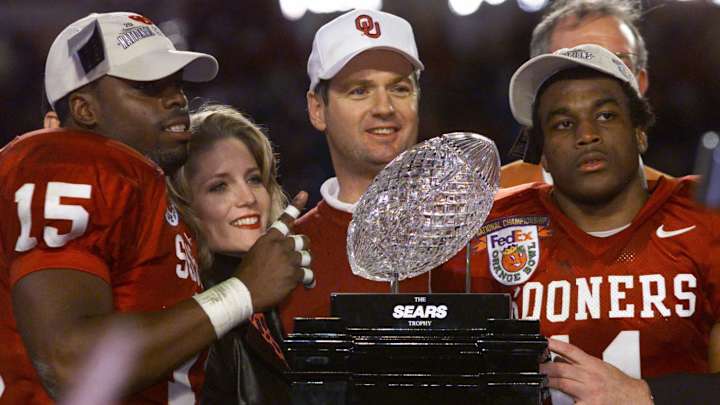Regardless of Conference Affiliation, Oklahoma Has Still Won 7 National Titles

Oklahoma football claims seven national titles.
There are 11 unclaimed titles as well, depending on whom you ask: 1915, 1949, 1953, 1957, 1967, 1973, 1978, 1980, 1986, 2003, 2008.
The Sooners have also won 50 league championships over the years while not playing in the Southeastern Conference.
However, it hasn't won a national championship in over 20 years, and has yet to win a game in the College Football Playoff.
Nevertheless, here's a look at the seven:
1950
Bud Wilkinson's fourth team at Oklahoma may not have been his best, but it was obviously still pretty good.
Coming off a 1949 season that saw the Sooners finish undefeated, and outscored opponents 399-88 (only to finish No. 2 in the polls to Notre Dame), the rebuilding year turned into a national title run.
Led by consensus All-Americans Leon Heath and Jim Weatherall, the offense continued to sport a high-power offense, that included the likes of Frankie Anderson, Claude Arnold, Tom Catlin, Buddy Jones and Billy Vessels.
Vessels scored 15 touchdowns in 1950, two years before he won the program's first Heisman Trophy.
Oklahoma opened the season with a 28-0 victory, and then pulled off a stunning comeback against Texas A&M. With 37 seconds to go and first-and-goal, Arnold called two plays in the huddle in case the first one didn't score, but would only need the one as fullback Leon "Mule Train" Heath took a pitch and darted into the end zone.
The following week saw another dramatic finish, this time against rival Texas. On fourth down, Texas fumbled the snap on a punt attempt and OU took over at the 11-yard line. Vessels scored from there and Weatherall, who doubled as OU's kicker, made the extra point for the 14-13 victory.
"Our boys have a world of heart," Wilkinson said. "It took a fumbled punt to beat Texas, but it seems if you play hard enough, things like that will happen."
It wasn't until late November, after a 41-7 victory over Missouri, that Oklahoma secured the top spot in the AP poll for the first time in school history. It subsequently won a shootout against Nebraska, and beat Oklahoma State to wrap up the national title, which was still decided at the end of the regular season.
However, it lost to Paul "Bear" Bryant's Kentucky Wildcats in the Sugar Bowl, snapping a 31-game winning streak.
1955
Wilkinson was quoted as saying prior to the start of the season, "I don't think we're going to be nearly as good a football team as people think."
Eight weeks into the season, the Sooners had risen to No. 1, where they would stay. As part of the legendary 47-game winning streak, Oklahoma polished off a perfect 11-0 regular season with four straight shutouts and a 20-6 victory over No. 3 Maryland in the Orange Bowl.
"That's the most satisfying victory we've ever had," Wilkinson said after the 20-6 victory in Miami.
The Sooners led the nation in total offense, rushing offense and scoring offense.
1956
The Sooners enjoyed another undefeated season and won back-to-back titles even though conference rules prohibited teams from making bowl appearances in consecutive years.
Oklahoma's powerful offense was led by running backs Tommy McDonald and Clendon Thomas, who combined for 1,670 yards and 35 touchdowns. The offensive line was led by Heisman Trophy finalist Jerry Tubbs, despite playing center.
For the second straight season, the Sooners led the nation in rushing offense with 391 yards per game, total offense with 481.7 yards per game, and scoring offense with 46.6 points per game. They outscored their opponents 466-51 en route to a perfect 10-0 season.
Meanwhile, the defense logged six shutouts and forced Notre Dame quarterback Paul Hornung, the 1956 Heisman Trophy winner, into his worst performance of the season. The final score of the game was Oklahoma 40, Notre Dame 0.
1974
Sooners fans still argue about whether this was Barry Switzer's best team.
Only one opponent played Oklahoma within 14 points and four failed to score a touchdown. Meanwhile, it led the nation in scoring offense with an average of 43 points per game en route to an 11-0 finish.
The team sported eight All-Americans. The wishbone offense, featuring running back Joe Washington, fullback Jim Littrell and quarterback Steve Davis, averaged 73.9 rushing attempts per game. It still stands as an NCAA record.
The defense was led by senior All-American linebacker Rod Shoate, playing behind a ferocious line with Lee Roy and Dewey Selmon, and defensive end Jimbo Elrod.
"God Bless Mrs. Selmon" was a popular bumper sticker in Oklahoma, and also how some fans closed prayers
If there was one criticism, it was that the Sooners played only two ranked opponents. It defeated No. 17 Texas 16-13, and No. 6 Nebraska 28-14. Oklahoma didn't play a bowl game due to NCAA probation.
1975
Having won 20 straight games, and with an unbeaten streak of 29, Oklahoma went into the season looking like it was on cruise control.
The defense appeared to be even better than the year before. Lee Roy Selmon won both the Outland Trophy and the Lombardi Award as the nation's best lineman while still playing next to his brother Dewey and All-American Jimbo Elrod.
The wishbone offense was led by senior quarterback Steve Davis, halfbacks Joe Washington and Horace Ivory, and receivers Tinker Owens and Billy Brooks.
But the Sooners had to squeak by Miami, Colorado and Texas, which cost it the No. 1 ranking, lost to Kansas and barely got past Missouri.
The team's fate would be determined in a showdown with No. 2 Nebraska. Oklahoma forced six Nebraska turnovers, including three in the fourth quarter, and converted five into touchdowns, running away with a convincing 35-10 victory to claim the conference crown.
Back up to No. 3, the Sooners headed to their first bowl game under Barry Switzer, an Orange Bowl matchup with Michigan, needing help for a shot at the national title. UCLA upset top-ranked Ohio State in the Rose Bowl, and Oklahoma prevailed in the 14-6 slugfest over the Wolverines.
1985
The physical defense paced the Sooners, who began the season with Troy Aikman at quarterback, but had to turn to true freshman Jamelle Holieway to lead Oklahoma to the national title.
One of the regular-season highlights was a 14-7 victory over Texas in the Red River Rivalry. The Longhorns were held to just four first downs, with none in the second half, and 70 yards of total offense.
"This was the greatest defensive performance by an Oklahoma team since I have been here and that's 20 years including the time I was an assistant," Barry Switzer said following the win.
It was during the 27-14 loss to Miami that Aikman suffered a broken leg that led to Holieway taking over. The Sooners subsequently rolled through their next four opponents with a combined score of 189-26 to reestablish its title chances.
Holieway set a single-game total offense record at Missouri with 324 yards (156 rushing and 168 passing), breaking the old mark (323 yards) set in 1971 by Jack Mildren against Iowa State.
Again the Sooners needed help during the bowls, and got it. Oklahoma took a No. 3 national ranking into the Orange Bowl, and toppled No. 1 Penn State, 25-10. That, coupled with Miami's loss to Tennessee in the Sugar Bowl, vaulted the Sooners to their sixth national championship.
Oklahoma's defense held Penn State to 10 first downs and just 77 yards rushing, while intercepting four passes. Butkus Award winner Brian Bosworth was credited with 13 solo tackles.
2000
Bob Stoops would have Oklahoma in the running for the national championship every year, but only won one national title.
The young 2000 team posted monster numbers in September, outscoring its opponents 176-51, but then had three nationally-ranked opponents for the subsequent month: No. 10 Texas, No. 2 Kansas State and No. 1 Nebraska.
It's now referred to as "Red October."
The Sooners dismantled the Longhorns, 63-14, won at Kansas State, 41-31, and toppled the top-ranked Huskers, 31-14. The victories against KSU and Nebraska marked the first time in NCAA history that one team had defeated the No. 1 and No. 2 ranked teams in consecutive games.
But that doesn't mean that things suddenly got easier for the Sooners.
At Texas A&M, linebacker Torrance Marshall intercepted a pass and returned it 41 yards for the game-winning touchdown. The Aggies drove to the Sooner 10-yard line on its next possession, but were stopped four times trying to get into the end zone.
In the Big 12 Championship Game, a rematch against Kansas State, quarterback Josh Heupel accounted for 21 points with a touchdown run and two scoring passes. But it took a career-long 46-yard field goal by Tim Duncan with 1:25 to play to secure the victory.
Finally, the Sooners beat Bobby Bowden and FSU, 13-2, at the Orange Bowl in Miami for the national championship.
This is the fourth story in a series that will examine the history of the Sooners football program, and what it will bring to the SEC. Parts of this post originated from the book, Huddle Up: Oklahoma Football.
Welcome to the Southeastern Conference, Oklahoma!
Oklahoma Football Traditions Include a Lot More Than 'Boomer Sooner'
Whatever You Call the Red River Rivalry, Oklahoma Has Owned It Lately
